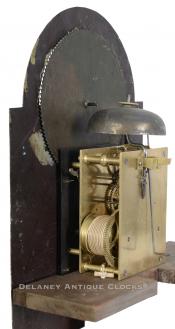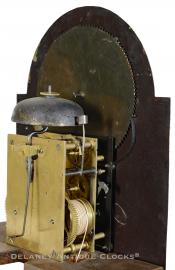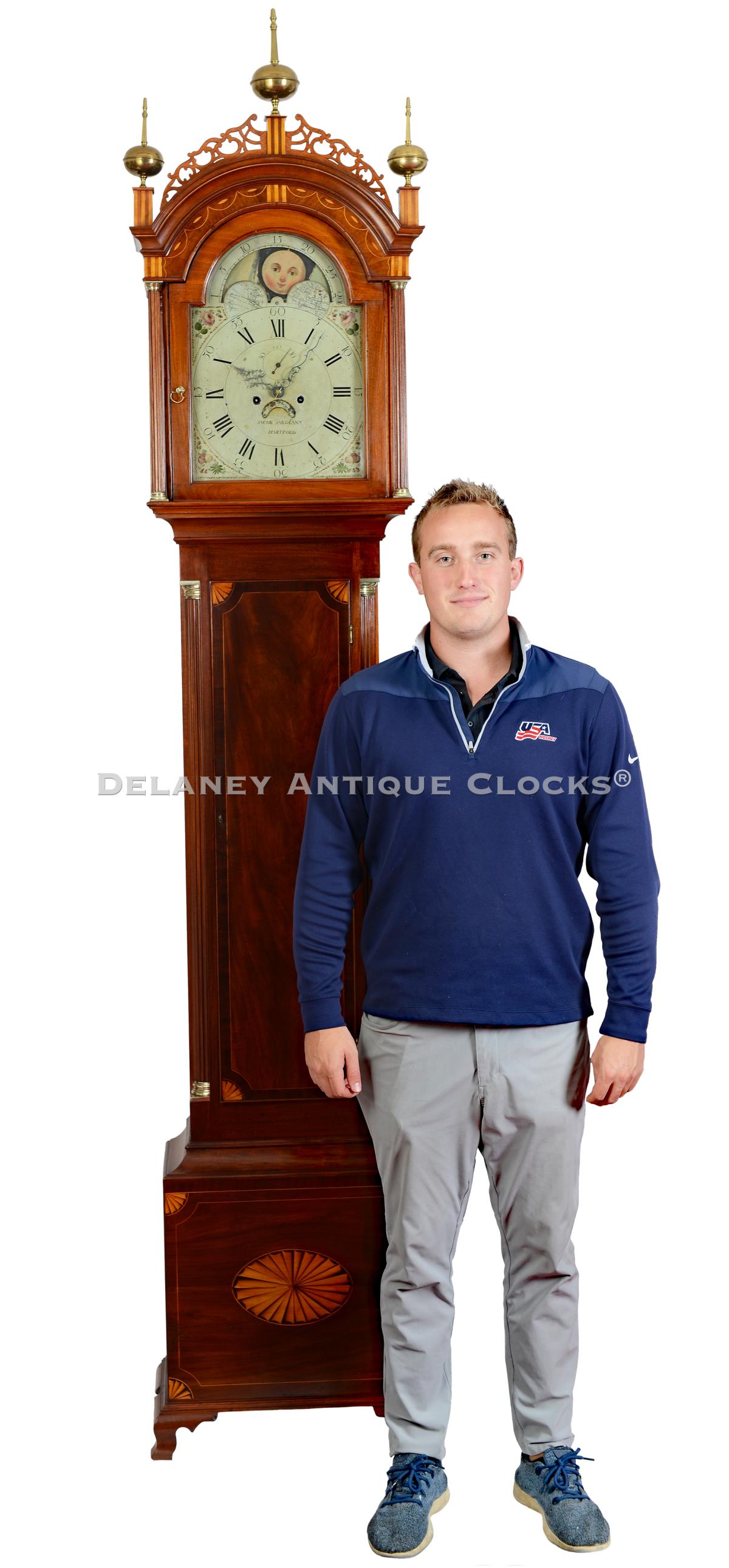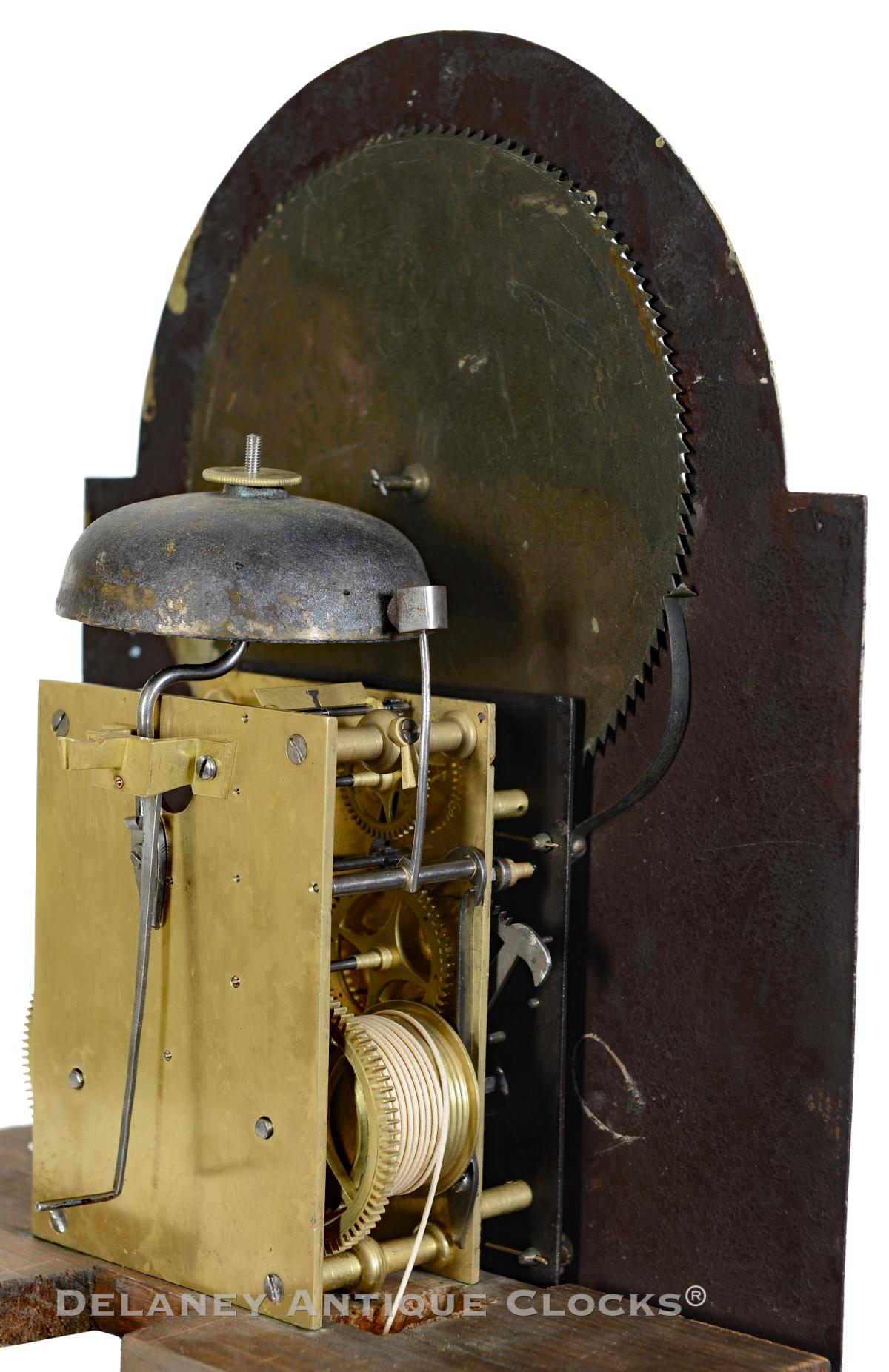Jacob Sargeant, Hartford, Connecticut. An important inlaid mahogany tall clock. 223243.
This elaborate parquetry inlaid tall case clock with dial Jacob Sargeant stands taller than most. The case measures 8 feet 10 inches tall to the top of the center finial, making it the tallest clock in our shop by more than 6 inches.
This veneered and inlaid mahogany case was undoubtedly designed to attract attention. It is built on a seldom-seen scale, suggesting it was custom-ordered for a specific location by a client with a particular need. The cabinet is also decorated with inlay patterns associated with the best American designs. The restored finish highlights the grain patterns in the mahogany wood and the contrast between the darker mahogany and the multiple light wood inlays.
The case is supported on four applied ogee bracket feet. These are well-formed and feature c-scroll returns. The crotch mahogany veneered base panel is inlaid. Centered in this panel is a full oval-shaped patera featuring 21 individual shaded fan blades. Applying heat through sand darkens the area contacted. This treatment provides visual depth by creating a shadow, and the element appears three-dimensional. This artistic element is used on the eight additional quarter fans to decorate this case. The first four-quarter five-bladed fans decorate the corners of the base panel. The radius of this design is framed with a line inlay. A single line inlay forms a frame with ovolo corners. The waist door is formatted similarly, except that it includes a cross-banded detail. The central panel features a selection of veneer that exhibits an excellent grain pattern. This door is trimmed with an applied molding along the outer edge. The door provides access to the case's interior, where one will find a brass-covered pendulum bob and two tin can drive weights. The front corners of the waist are fitted with fluted quarter columns. These terminate in brass quarter capitals. The bonnet features an open fancy fretwork design. The supporting plinths are decorated with alternating light and dark wood vertical inlays. They are also capped at the top and support brass ball-and-spike finials. This arched hood molding is complex. This design element is one we see in many cases designed by Stephen Badlam, who was working in Dorchester, Massachusetts. The molding includes a frieze section. This is decorated with an interesting inlay pattern with three bookend vertical inlays and an alternating pattern of thin line swags that center ellipses. This additional detail work is created with light wood and conforms to the shape of the arched molding. Fully turned and fluted bonnet columns support the upper bonnet molding. These are mounted in brass capitals. The arched bonnet door is fitted with glass.
This colorfully painted iron dial was manufactured in England by the Wilson firm. It is fitted with a false plate and is signed at the top. The dial is oversized, measuring 14 inches across and almost 19.75 inches in height. In the arch or lunette of this dial, one will find the automated feature of a moon phase or lunar calendar. The four spandrel areas are decorated with colorfully painted floral themes. The time track features Arabic five-minute markers and Roman-style hour numerals. A dotted minute ring separates them. A subsidiary seconds-dial and the calendar display are in the traditional locations. This dial is signed "JACOB SARGEANT / HARTFORD" in block lettering.
This fine movement is constructed in brass and is of good quality. Four-turned pillars support the two brass rectangular-shaped plates. Hardened steel shafts support the polished steel pinions, brass gearing, and a recoil escapement. The winding drums are grooved. The weight-driven movement is designed to run for eight days on a full wind. It is a two-train or a time-and-strike design with a rack and snail striking system. As a result, it will strike each hour on the hour on a cast iron bell mounted above the movement.
This beautiful clock was made circa 1795.
Inventory number 223243.
Jacob Sargeant was born in Mansfield, Connecticut, on February 28, 1761. He was the son of Samuel and Hannah (Baldwin) Sargeant. It is recorded that he trained Nathan Storrs in 1781. We now speculate that he may have been trained as a clockmaker by Peregrine White of Woodstock, Connecticut, due to the similarities of movement construction found in examples by both clockmakers. Jacob also worked as a gold and silversmith. Jacob worked in Mansfield from 1784 through 1789 as a goldsmith and silversmith. He advertised in The Connecticut Gazette and the Universal Intelligencer (Mansfield Center CT) on January 11, 1784, ". . . shop in Mansfield makes clocks and watches, gold and silversmith work." On January 30, 1785, Jacob married Olive Paine of Canterbury, Connecticut, in Mansfield Center, CT. In 1790, he trained his brother Thomas Sargeant (1773-1834). In 1790, Jacob moved to Springfield, Massachusetts, and advertised in the Hampshire Chronicle (Springfield, MA) 1790 as a gold- and silversmith. Here, he continued to make clocks and sell jewelry and employed his younger brother Thomas as an apprentice. He also trained Shubael Storrs in 1790 and Charles Brewer in 1791. In October 1795, he advertised in the "Courant," a Hartford newspaper, that he had moved or "Established his business at the sign of the Golden Watch a few rods South of the State House in Hartford. "By 1800, Sargeant had a retail business which was one of the largest in Hartford; he sold his own silver, the silver of other makers, guns, and clocks. While in Hartford, he trained Joseph Church in 1816 and Walter Ward Hart in 1820. He remained in Hartford until he died in 1843. Jacob Sargeant's shop sign is now in the Connecticut Historical Society collection.
We have seen and owned a fair number of tall clocks made by Jacob Sargeant. The earliest examples feature engraved brass dials finished with a silver wash. One such example, which is signed Hartford, features a musical movement. It is a three-train clock and plays one of six tunes on the hour. The four spandrel areas are decorated with depictions of the four seasons. This dial is thought to have been engraved by Richard Brunton, a well-known maker of dials and bookplates and, among other talents, a counterfeiter of currency. The case is cherry and is attributed to Aaron Chapin of East Windsor. This case exhibits the Hartford / Norwich form. A second example also features an engraved dial. That dial is silver and features a rocking ship in the arch. The four spandrel areas are skillfully engraved depictions of the four seasons. This case is also cherry. It features an applied swan's neck pediment, which is pierced. (Chapin Case?) The majority of the other examples found have been painted dial clocks.














